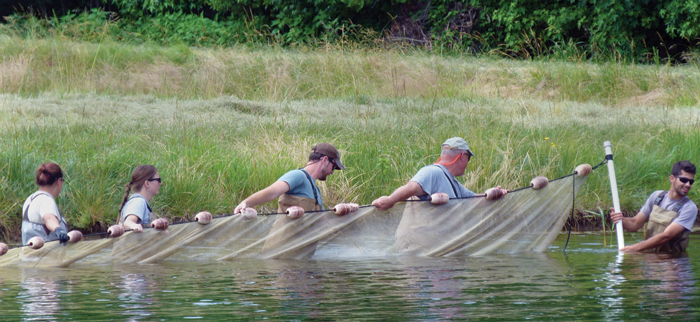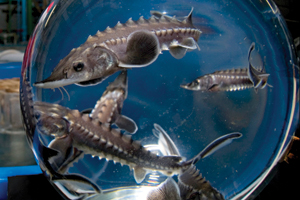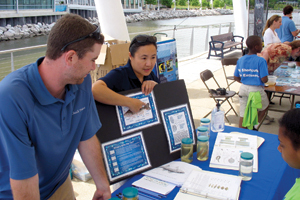Conserving, Protecting and Restoring: Chalk Point Aquaculture Center

Biologists seining fish ponds at Chalk Point; by Pilantana Anderson
The aquaculture center at NRG’s Chalk Point Generating Station was built in 1987 to support the Maryland Department of Natural Resources striped bass restoration activities.
It produced approximately 3.6 million striped bass between 1985-2000. Out of those 3.6 million, 2.5 million were tagged and released into the Chesapeake Bay. The rest were used for research or recreational stocking in lakes and reservoirs. Today, the rockfish raised at the center are used for research, education or stocking.
| NRG Energy is a power company with aquaculture facilities at its Aquasco station on the Patuxent River. The facility provides extensive grow out services and supplies to assist in various fish culture operations. |

Distribution Fishing Status Habitat and spawning Juveniles spend several years in large freshwater rivers, or they may move down into more brackish waters before becoming migratory. As sub-adults, they then move into coastal waters to mature. Little information exists concerning the movements of Atlantic sturgeon once they reach the ocean. Note: Virtually all Atlantic sturgeon observed in Maryland’s portion of the Chesapeake Bay since 1955 have been sub-adults 1-5 feet in length. Genetic analysis has determined these fish to be migrants from other southern and northern coastal stocks. Fun Fact |
Expanding efforts
Since 1991, Chalk Point has included American and hickory shad restoration efforts, with targets set for the Tuckahoe, Choptank, Patuxent and the Patapsco rivers. Hundreds of thousands of shad fingerlings are released into these rivers each year. In the past, the center has raised yellow perch, largemouth bass, blue-back herring and alewife for various restoration and stocking programs.
“The original purpose of the aquaculture facility was to culture striped bass juveniles for restoration stocking and research,” says Maryland Fish Health and Hatcheries Program Manager Brian Richardson. “That recovery provided an opportunity to expand the scope of the facility through culture of other species that would benefit the Chesapeake Bay as a whole.”

Sturgeon; by Jay Fleming
Sturgeon success
Research and restoration on the Atlantic sturgeon began in 2004.
As of this past fall, Chalk Point has raised approximately 200 Atlantic sturgeon of the Canadian, Hudson River and Chesapeake Bay strains.
Maryland Anadromous Restoration Program Manager Chuck Stence explains, “NRG currently houses more than 30 adult Atlantic sturgeon, each weighing in excess of 60 pounds. The sturgeon are cultured in indoor tanks, then moved to earthen ponds in the winter. These culture activities are a tremendous achievement and crucial to ensure the continued success of ongoing restoration projects.”
Currently, the department and its partners work with the Atlantic States Marine Fisheries Commission and National Marine Fisheries Service to continue with conservation efforts under the current Endangered Species Act listing status.
“Maryland maintains the only Atlantic sturgeon captive brood restoration project in the United States,” explains Richardson. “NRG cultures the majority of the captive brood stock at Chalk Point. This collaboration has generated important information, from nutrition to surgical techniques to maturity. This research is critical to the success of the sturgeon restoration and invaluable to researchers coast wide.”

National bass tournament at national harbor with living classrooms; by Pilantana Anderson
Public outreach
This prehistoric fish is often included in hatchery tours and live fish exhibits to further educate the public about the importance of healthy fisheries.
The outreach program has grown considerably over the past decade. Each year, Chalk Point participates in various events by either displaying a live fish exhibit or setting up an educational station. These exhibits are especially popular with students with an interest in marine life, aquaculture and environmental preservation.
A naturalist with the Watkins Nature Center, Paula McNeil says, “The aquaculture center has allowed our summer day camp children to see an endangered species up close and personal; a much better experience than going to the zoo or an aquarium!”
Among the long-term supporters of NRG’s outreach and aquaculture program are the Calvert Marine Museum, Watkins Nature Center, Morgan State University Patuxent Environmental and Aquatic Research Laboratory, Starmaker Learning Center and St. Mary’s River Project.
“Over the years, I have seen a lot of partnerships that seem to be in-name only,” says Joseph Manning Hatchery Manager Dave Sien. “They often fade before the press release does, but this partnership is a unique, cooperative effort that has spanned decades.”
The rewards of fish restoration and educating the public are endless. For NRG staff, knowing that the fish raised at Chalk Point from larval stage are now thriving in the rivers is an awe-inspiring feeling. It is the hope of department and NRG that this program continues to thrive well into the future.
Article by Pilantana Anderson—Chalk Point Aquaculture Center director. Appears in Vol. 20, No. 2 of the Maryland Natural Resource magazine, spring 2017.


 1-888-373-7888
1-888-373-7888 233733
233733